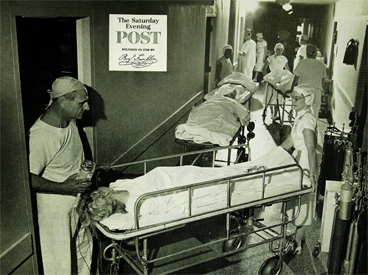A similar view has been presented by Dr. Harry F. Becker, for many years medical director of the Michigan Blue Cross plan.
“Prepayment has provided needed hospital care for thousands of people who might otherwise have had to forgo necessary attention,” he said. “But it has also resulted in millions of unnecessary days of hospital-bed occupancy and many millions of unessential procedures. This, perhaps more than any other factor, is presently pricing hospital care out of the pockets of the lower-income segments of our population.”
His conclusions were based on a survey of 12,102 consecutive cases conducted by the Michigan State Medical Society in 25 typical Michigan hospitals.
The doctors discovered that the 12,102 patients had spent a total of 76,238 days in the hospital and that 11,172 of these days “were considered to be unnecessary to the recovery, safety or reasonable comfort of the patient.”
While 14 percent of the patients paying their own bills were found to have come to the hospital unnecessarily or to have stayed unnecessarily long, this faulty use was attributed to 30 percent of the patients with commercial insurance and to 36 percent of those with Blue Cross.
“Nearly one out of five days used by Blue Cross patients was not necessary,” the doctors reported. “One out of eight Blue Cross patients entered the hospital for laboratory or X-ray examinations, although hospital outpatient departments were performing similar examinations on similar patients every day.”
Doctor Becker emphasized that such needless use of hospitalization contributed “not one iota to the essential quality of care for the patient.”
In Michigan alone, he calculated, this form of hospital abuse costs nearly $5 million a year. For the United States, it may cost more than $100 million a year.
“In the long run,” he said, “the subscriber pays for this misuse in the increased rates for his contract.”
Some of the needless but expensive hospitalization has been attributed to certain health-insurance policies, which have been described as invitations to chiseling. These pay for medical care given to a hospitalized patient, but do not cover the same care rendered at home or in a doctor’s office. Still other abuses have been blamed on inefficient hospital policies, unreasonable scheduling, log jams in operating rooms, and the traditional shutdowns of laboratories over the weekend.
“In too many hospitals,” claims Dr. Anthony J. J. Rourke, past president of the American Hospital Association and nationally famed hospital expert, “patients are brought in on Friday and kept in an expensive bed over the weekend—at twenty or twenty-five dollars a day—until the laboratory reopens on Monday and their diagnostic tests can be performed.”
Some hospitals, in an apparent effort to be friendly to Blue Cross patients, have permitted them to take home enough medicines to last them for two or three months. Such take-home medicines can then be charged against the health-insurance policy.
During the past few years, many leaders have accused hospitals of being entirely too friendly toward Blue Cross. Their increasing animosity has been directed toward the widespread though unpublicized system of hospital rebates to Blue Cross. Under this system, patients with Blue Cross are generally charged from 5 to 15 percent less than are patients with commercial insurance or with no insurance at all. To make up for the deficit, the hospitals usually raise their prices to non-Blue Cross patients, run money-raising drives, or turn for help to the local Community Chest.
Blue Cross officials have defended this custom by claiming the rebate represents savings made possible by effective bill collecting. Insurance companies and employers have decried it as a low blow and an outrageous discrimination. Patients without any insurance, who presumably have never heard of the rebate system, pay their higher bills and squawk at the high costs of medical care.
Against this background of dispute, controversy and assertions of chiseling on all sides—with at least some evidence to support the assertions—two of the most remarkable developments in health insurance have occurred during the past few years.
One is the discovery, reported by a recent Michigan State Medical Society survey, that most people are not primarily interested in lower premiums. The overwhelming majority want more protection and are willing to pay higher premiums to get it.
The other is the introduction of a radically new kind of health insurance—or more accurately, budgeting for medical costs—which is based on the rather startling concept that maybe you can trust people, after all.
Become a Saturday Evening Post member and enjoy unlimited access. Subscribe now



